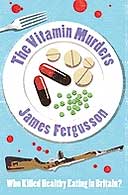
The Vitamin Murders
by James Fergusson
264pp, Portobello, £12.99
In the summer of 1952, the eminent biochemist, Sir Jack Drummond, was in France on holiday with his wife, Anne, and their 10-year-old daughter. While camping in Provence, they were attacked in the middle of the night. Anne was shot as she slept. Drummond struggled with her killer, but was shot too. Their daughter managed to run a hundred yards before she was caught and her skull crushed by the butt of the same gun that had killed her parents.
Fifty years later, James Fergusson happened to be holidaying in the area and stumbled across their graves. Fergusson is a British journalist whose first book, Kandahar Cockney, described his friendship with an Afghan refugee in London. As soon as he started researching the Drummonds, he became absorbed by the mystery of who had killed them and why.
Fergusson quickly discovered that Drummond was a fascinating, important figure, "a noted pioneer in the field of human nutrition". With Anne, who was both his research assistant and second wife, he had written a history of English eating habits, The Englishman's Food: Five Centuries of English Diet. During the second world war, he was scientific adviser to the Ministry of Food, where he led a campaign of public education which had the extraordinary and entirely unexpected effect of making the British healthier than they had ever been.
Drummond travelled to besieged Malta and the occupied Netherlands, where his efforts helped to prevent mass starvation. "Drummond mixture", a kind of porridge made to his recipe, was distributed at the newly liberated concentration camps and saved thousands of lives. After the war, he was appointed director of research at Boots and settled into a comfortable, prosperous post-war life. There didn't seem to be any reason why someone should want to kill him.
After a chaotic trial, a local farmer was sentenced to death but, on the orders of De Gaulle, later released. So, who really killed the Drummonds? And why? Conspiracy theorists point the finger at the KGB, but Fergusson comes up with a more intriguing suspect: the chemical industry, who must have been worried that Drummond would insist that Britons ate wholemeal bread, free-range chickens and organic veg rather than pap pumped with chemicals.
Fergusson counterpoints his researches into Drummond's life and death with his own nutritional transformation from junk-food junkie to foodie puritan. Once a connoisseur of supermarket ready-meals, he soon finds himself subscribing to a weekly box of organic vegetables, shopping in a farmers' market, poring over papers written by nutritionists, and even being tested to discover what hidden chemicals are swimming through his body.
His researches are kick-started by his wife's pregnancy and her "almost sacred mission to purify her body". Each new piece of information makes him more paranoid about what he, she and their unborn child are eating. Chickens are now reared so fast, he discovers, that they don't have the time to put on any muscle, which is why "a modern supermarket bird contained twice as much fat as its equivalent in 1940". Milk is no different: in the past 60 years, "British milk had lost 2% of its calcium, 21% of its magnesium and 60% of its iron". Not only are we eating more, but our food is getting worse.
And then there are the chemicals. Paying £75 to a Harley Street doctor certified by "the American College of Nutrition", Fergusson drops his trousers and allows an Austrian nurse to draw a syringeful of fat from his bum. Hearing that he lives in London, the nurse says, "I think you will be all right. London is safer to live in than the countryside these days. There are so many pesticides in the countryside."
Even so, the test reveals that Fergusson "contained significantly high levels of DDT, DDE, HCB, PCBs, p-dichlorobenzene, dieldrin and chlordane". Analysis of his wife's breast-milk reveals the presence of all these too, although they are described as being "well within background exposure levels". Panicked, Fergusson and his wife jump into an infra-red sauna and stay there for 20 minutes, naked, scrubbing themselves with a loofah, sweating out toxins.
As he was writing this book, Fergusson must have been hoping that he would unearth some new and conclusive piece of information which would knot together his two separate narrative strands into one satisfying whole. He does manage to find a professor of nutrition who hints that "Drummond's murder was a keystone in a dastardly campaign of corporate suppression, without which the course of nutritional history in Britain might have been completely different."
Eventually, Fergusson discovers that the conspiracy theorists are wrong and the official explanation of the murders was almost certainly correct: the Drummonds were victims of a random killing by a local drunk. There was no reason for the chemical industry to murder Drummond, because he was already on their side. His lucrative work for Boots was directly linked to the proliferation of chemicals in food. It is a disheartening end to Fergusson's quest: just as our food, our bodies and our entire world have been entirely infiltrated by chemicals, so Drummond was contaminated by the very forces that he seemed to have devoted his life to fighting.

